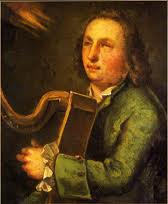Annotation:Maurice O'Connor (1): Difference between revisions
No edit summary |
m (Text replacement - "garamond, serif" to "sans-serif") |
||
| (2 intermediate revisions by one other user not shown) | |||
| Line 1: | Line 1: | ||
=='''Back to [[{{BASEPAGENAME}}]]'''== | =='''Back to [[{{BASEPAGENAME}}]]'''== | ||
---- | ---- | ||
<p><font face=" | <p><font face="sans-serif" size="4"> | ||
'''MAURICE O'CONNOR [1].''' "O Connor." Irish, Planxty (6/8 time). G Major. Standard tuning (fiddle). AABC. Composed by blind Irish harper Turlough O'Carolan (1670-1738), one of several airs he composed in honor of Maurice O'Connor, head of the O'Connors of Offaly in Carolan's era. | '''MAURICE O'CONNOR [1].''' "O Connor." Irish, Planxty (6/8 time). G Major. Standard tuning (fiddle). AABC. Composed by blind Irish harper Turlough O'Carolan (1670-1738), one of several airs he composed in honor of Maurice O'Connor, head of the O'Connors of Offaly in Carolan's era. | ||
[[File:carolan.jpg|200px|thumb|left|Turlogh Carolan]] | [[File:carolan.jpg|200px|thumb|left|Turlogh Carolan]] | ||
The stronghold of the O'Connors during Elizabethan times was Daingean Ui Fáilghe (Fortress of Offaly), until the lands were broken up under the English, and given English names. His father died young, and Maurice, head of | The stronghold of the O'Connors during Elizabethan times was Daingean Ui Fáilghe (Fortress of Offaly), until the lands were broken up under the English, and given English names. His father died a rebel against the English, leaving a widow and young children, and, since the family lands were attained, they were destitute and retired to a convent in County Kerry. Maurice, head of the family, nevertheless sought his fortune in London, where became a member of the Inner Temple and did indeed strike it rich as a member of the English Bar (although he had to maintain an expedient conversion to Protestantism because of the penal laws that excluded Catholics from practicing law). Having invested wisely in real estate and other ventures, O'Connor retired from his English life and returned to Ireland, where, in 1725 he married Lady Mary Plunkett, youngest of three sisters and co-heirs of the 5th Earl of Fingall, a distinguished Irish Catholic family. | ||
<br> | <br> | ||
<br> | <br> | ||
| Line 11: | Line 11: | ||
<br> | <br> | ||
</font></p> | </font></p> | ||
<p><font face=" | <p><font face="sans-serif" size="4"> | ||
''Source for notated version'': Samuel, Ann and Peter Thompson's '''Hibernian Muse''' (London, c. 1786, p. 24) [O'Sullivan]. It was also printed by John Lee (1780), although O'Sullivan believed the third part to be defective. | ''Source for notated version'': Samuel, Ann and Peter Thompson's '''Hibernian Muse''' (London, c. 1786, p. 24) [O'Sullivan]. It was also printed by John Lee (1780), although O'Sullivan believed the third part to be defective. | ||
<br> | <br> | ||
<br> | <br> | ||
</font></p> | </font></p> | ||
<p><font face=" | <p><font face="sans-serif" size="4"> | ||
''Printed sources'': '''Complete Collection of Carolan's Irish Tunes''', 1984; No. 115, p. 84. O'Sullivan ('''Carolan: The Life, Times and Music of an Irish Harper'''), 1958; No. 115, p. 162. | ''Printed sources'': '''Complete Collection of Carolan's Irish Tunes''', 1984; No. 115, p. 84. O'Sullivan ('''Carolan: The Life, Times and Music of an Irish Harper'''), 1958; No. 115, p. 162. Samuel, Anne & Peter Thompson ('''The Hibernian Muse'''), London, 1787; No. 39, p. 24. | ||
<br> | <br> | ||
<br> | <br> | ||
</font></p> | </font></p> | ||
<p><font face=" | <p><font face="sans-serif" size="4"> | ||
''Recorded sources'': <font color=teal></font> | ''Recorded sources'': <font color=teal></font> | ||
</font></p> | </font></p> | ||
Latest revision as of 14:20, 6 May 2019
Back to Maurice O'Connor (1)
MAURICE O'CONNOR [1]. "O Connor." Irish, Planxty (6/8 time). G Major. Standard tuning (fiddle). AABC. Composed by blind Irish harper Turlough O'Carolan (1670-1738), one of several airs he composed in honor of Maurice O'Connor, head of the O'Connors of Offaly in Carolan's era.

The stronghold of the O'Connors during Elizabethan times was Daingean Ui Fáilghe (Fortress of Offaly), until the lands were broken up under the English, and given English names. His father died a rebel against the English, leaving a widow and young children, and, since the family lands were attained, they were destitute and retired to a convent in County Kerry. Maurice, head of the family, nevertheless sought his fortune in London, where became a member of the Inner Temple and did indeed strike it rich as a member of the English Bar (although he had to maintain an expedient conversion to Protestantism because of the penal laws that excluded Catholics from practicing law). Having invested wisely in real estate and other ventures, O'Connor retired from his English life and returned to Ireland, where, in 1725 he married Lady Mary Plunkett, youngest of three sisters and co-heirs of the 5th Earl of Fingall, a distinguished Irish Catholic family.
Carolan composed this air and song on the occasion of O'Connor's purchase of Coote Hall, County Roscommon, from the Coote family. It was a home where Carolan was a welcome guest in his travels, although by 1729 O'Connor have moved to a new residence, Gortnamona (named Mount Pleasant during O'Conner's tenure), in County Offaly, where he died in 1740. His wife Mary survived until 1759. See O'Sullivan's extensive note (Carloan, 1958, pp. 265-266) and Alice Stopford Green's Old Irish World (1912, pp. 100-129) for more on O'Connor and his family.
Source for notated version: Samuel, Ann and Peter Thompson's Hibernian Muse (London, c. 1786, p. 24) [O'Sullivan]. It was also printed by John Lee (1780), although O'Sullivan believed the third part to be defective.
Printed sources: Complete Collection of Carolan's Irish Tunes, 1984; No. 115, p. 84. O'Sullivan (Carolan: The Life, Times and Music of an Irish Harper), 1958; No. 115, p. 162. Samuel, Anne & Peter Thompson (The Hibernian Muse), London, 1787; No. 39, p. 24.
Recorded sources:
